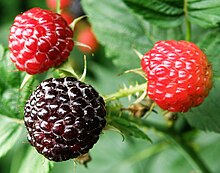 |
| Image Courtesy of Wikipedia. |
Rubus Occidentalis (also known as wild black raspberry, black caps, thimbleberry, and scotch caps) is a very common plant in western New York state (where I live). The official range where black caps can be found in the wild is through out North America. They very closely resemble raspberries. Like the raspberry, they share the white underside of the leaves, a fruit that is made up of druplets, similar flowers, and the thorny stems. It is argued that black caps have more thorns on their stems than raspberries. I personally don't know if this is true.
Black caps are ripe around midsummer in my region. As a child, I would go out with my brothers and pick them for our Mom to use in jam. We regularly at about half of what we picked. I was taught that the leaves picked around midsummer had the proper medicinal quality to treat premenstrual cramps and help lift the depression that women in my family experienced due to their menses. I was told that if you drank black raspberry leaf tea not at these times, it acted as a mild sedative.
We were taught that the fruit, consumed in large quantities, had a laxative effect. And, honestly, that one is absolutely true. It didn't stop my brother and I from eating what seemed like half our weight in black caps when they were ripe. At one point, one of us (I don't remember now if it was myself or one of my brothers.) was struggling with constipation. Our grandmother gave three teaspoonfuls of her black raspberry jam. It was no longer a problem after that. It was, however, not as effective as the plum jelly.
We were also taught that by looking through the canes of the plant around sunset, we could see nature spirits moving about the land. We were also taught that picking unripe berries off the plant discourages it producing more on that cane next year. The one bit of folk lore that made the biggest impression on me was one that came from one of my aunts. She told me that the Queen of the Fairies had her summer chariot made from a whole black cap berry, (The winter one being made from half of an empty hazelnut.)
No comments:
Post a Comment